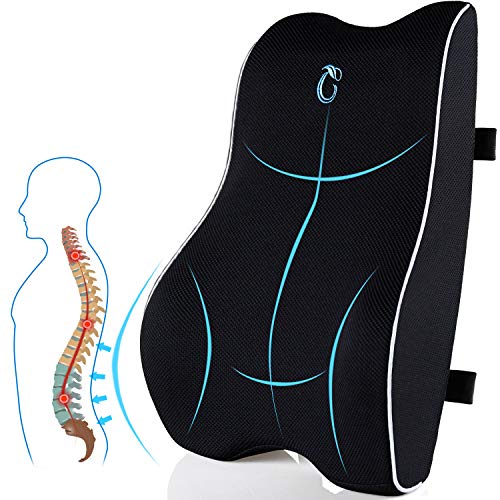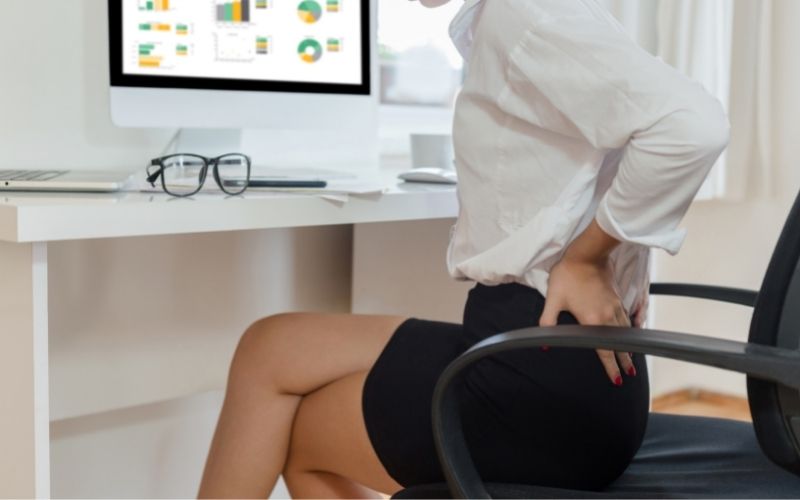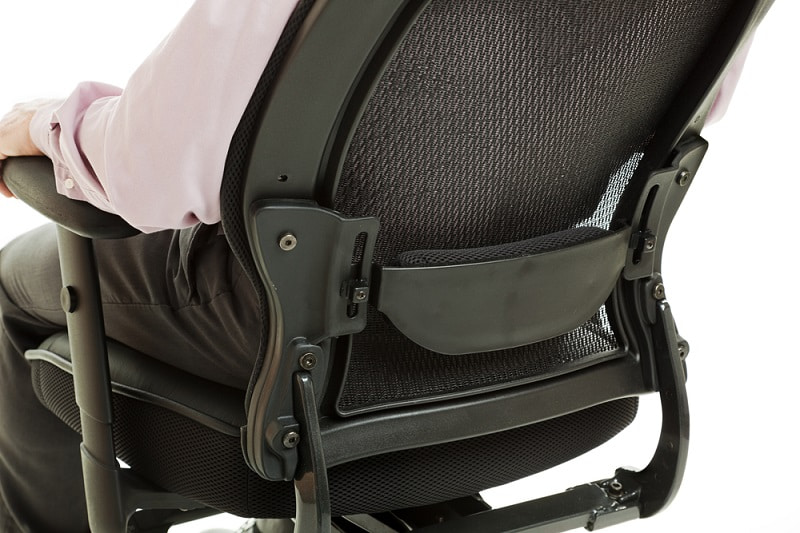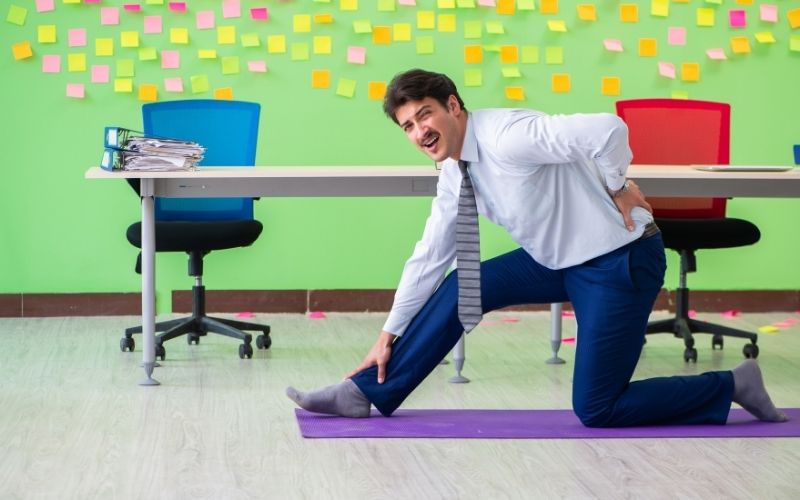Lumbar support features are often found in devices that support the lower back or lumbar region. So when lumbar support hurts your back and leaves you in pain, you end up asking, “Why does lumbar support hurt my back?” After all, isn’t it supposed to make you feel better?
Lumbar support is good for your back. It can improve productivity and function while reducing pain. Good lumbar support should support the spine’s natural curve. The four types of lumbar supports available are fixed, dynamic, adjustable, and external lumbar support.
Lumbar support can hurt your back due to reasons like static sitting positions, using the wrong chair, or not adjusting the chair correctly. You can remedy the issue by being active, stretching, and adjusting the chair to the correct height.
In this article, we’ll tell you if lumbar support is good for you, where good lumbar support should hit, why it hurts your back, and how you can avoid it.
Table of Contents
What is Lumbar Support?

Lumbar support is a feature that provides extra support to the lumbar region.
The lumbar is the lower part of the back. It is a group of five vertebrae attached to the pelvis.
Lumbar support is designed in a way to lessen the strain on the lower back while we are sitting. Adequate lumbar support is often a feature of most car seats and ergonomic work chairs.
The lumbar support is often built-in to office chairs but can sometimes be attached. It is usually made with breathable fabrics like mesh to encourage airflow and regulate the heat build-up while seated to avoid perspiration.
Is a Lumbar Support Good for Your Back?
Lumbar support is good for your back as it provides it support, prevents backache, and reduces back pain. It offers benefits like easing neck pain, improving posture, improving circulation, and reducing sciatica pain. It also helps you work well and sleep better.
Lumbar support achieves all of this by filling in the gap between your lower back and the seat.
There are four different types of lumbar support, which are often found on most office chairs. They are the fixed, dynamic, adjustable, and external lumbar support.
Fixed Lumbar Support

Fixed lumbar support is just what it sounds like. It cannot be adjusted and frequently has foam built in. They do the work but can sometimes be counterproductive as not all spines curve in the same way.
Dynamic Lumbar Support

The second is dynamic lumbar support, which automatically adjusts to a person’s posture. This lumbar support type is often the type available in most high-end ergonomic chairs.
Adjustable Lumbar Support

The third is adjustable lumbar support that allows for flexibility. They can be height adjustable to support any height, depth adjustable to adjust how the chair protrudes in and out, or firmness adjustable to control how soft or firm you want the lumbar support to be.
External Lumbar Support

The final lumbar support allows for greater flexibility since it can be attached as a separate piece to an already available office chair. They can be in the form of lumbar support pillows to accommodate a number of shapes and body sizes.
Where Should a Good Lumbar Support Hit My Back?

When seated, excellent lumbar support for the back should support the spine’s natural curve. This means that it should be able to fit flush on the back’s lower portion. So when you are seated, the lumbar support is located on the bottom of your chair.
If this is the case for your ergonomic office chair, the lumbar support should be able to keep your ears, shoulder and your hips or pelvis aligned in one straight line. Aside from that, it allows you to retain the inward curving of your lower spine.
Why Does My Lumbar Support Hurt My Back?
There are several reasons why the lumbar support on your chair is causing backache instead of preventing it. These include being static while sitting, using the wrong chair, and not adjusting the chair properly.
You might be static while sitting

One of the primary reasons for backache is prolonged static sitting, mainly when someone gets carried away with their work. This problem is primarily due to muscle strain caused by too much stress on the lower back muscles.
Muscle strains or pulled muscles are a tear in the muscle fibers because of overuse. If you are in one position for more than ten minutes while working, chances are this is the cause of your lumbar pain. On the other hand, torn or overstretched ligaments in your lumbar region can cause lumbar pain.
You might be using the wrong chair

Many factors can cause lumbar backache, and sometimes, it is because you have been using the wrong chair all along. Not all spines are built the same, and sometimes, some people have a flatter curve to their back, so it might be preferable to use a chair with less of a lumbar curve.
If you are sitting in a standard straight-back dining room chair, do you still feel the discomfort? Follow the ergonomic suggestions to make sure that the chair works for you. Office chair with deep curves might be forcing your lower spine to conform to the curve when it is not your spine’s natural curve.
The chair might not be adjusted correctly

If you don’t have a problem with the two issues cited above, then it might just be that your chair is not appropriately adjusted to conform to your height. Chairs have ergonomic features, so you can accommodate everything from the headrest to the chair height to your needs.
How to Avoid Lumbar Support Backache?

To avoid lumbar support backache, stay active while seated on your office chair. Stretch your back and move your legs. Walk around often. You can also try replacing the chair or adjusting the chair to suit you.
If a static posture has brought about your lumbar backache, the first solution is to stay active while seated on your office chair. Be mindful and avoid staying in one sitting position for too long to combat muscle strain.
You can stand after 30 minutes of just sitting down. Simply stretching your back and moving your legs will do so much. Walking will also be beneficial to promote healthy and adequate blood flow in your spinal structures.
For a person with a relatively “straighter” lumbar curve, try to assess where the problem is coming from. If you feel more comfortable and are not developing backaches in a straight chair, replacing your ergonomic chair with a more linear and more basic office chair might just be what will help.
For lumbar pains stemming from the lumbar support on your office chair, trying to adjust the chair to fit your height and size will help. All of these factors are important for overall lumbar health, from the elbow measurement to the resting eye level and armrest size.
Office chairs, especially high-end ones, are often highly-adjustable in almost all these aspects, so try adjusting your chair to conform to everything you need.
Final Thoughts
If your work requires sitting for long hours, the best thing you can do to lessen the burden on your spine is to opt for a chair with lumbar support.
Still, sometimes, they can also exacerbate back pain, so making sure that you have the right chair or not remaining in one sitting position for a long time will help.
If adjusting the seat settings or moving around doesn’t help, consider changing your office chair.

My name is Vance, and I am the owner of To Ergonomics. Our mission is to improve your workflow by helping you create a supportive and welcoming environment. We hope that you’ll find what you’re looking for while you’re here.

